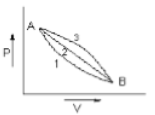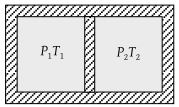A sample of an ideal gas is taken through a cycle a shown in figure. It absorbs 50J of energy during the process AB, no heat during BC, rejects 70J during CA. 40J of work is done on the gas during BC. Internal energy of gas at A is 1500J, the internal energy at C would be

(1) 1590 J
(2) 1620 J
(3) 1540 J
(4) 1570 J
एक आदर्श गैस का एक नमूना आकृति में दिखाए गए चक्र के माध्यम में ले जाया जाता है। यह प्रक्रम AB के दौरान 50 J ऊर्जा को अवशोषित करता है, BC के दौरान कोई ऊष्मा अवशोषित नही होती है, CA के दौरान 70 J को बहिष्कृत करता है। BC के दौरान गैस पर किया गया कार्य 40 J है। A पर गैस की आंतरिक ऊर्जा 1500 J है, C पर आंतरिक ऊर्जा होगी :

(1) 1590 J
(2) 1620 J
(3) 1540 J
(4) 1570 J


A gas is taken through the cycle A→B→C→A, as shown. What is the net work done by the gas?
(a)2000J
(b)1000J
(c)Zero
(d)-2000J
जैसा कि दिखाया गया है एक गैस चक्र A→B→C→A के माध्यम से लायी गई है। गैस द्वारा किया गया परिणामी कार्य क्या है?
(a) 2000J
(b) 1000J
(c) शून्य
(d) -2000J
Which of the following is not thermodynamical function ?
(1) Enthalpy
(2) Work done
(3) Gibb's energy
(4) Internal energy
निम्नलिखित में से कौन सा ऊष्मागतिकीय फलन नहीं है?
(1) एन्थैल्पी
(2) किया हुआ कार्य
(3) गिब्स ऊर्जा
(4) आंतरिक ऊर्जा
Following figure shows on adiabatic cylindrical container of volume V0 divided by an adiabatic smooth piston (area of cross-section = A) in two equal parts. An ideal gas is at pressure P1 and temperature T1 in left part and gas at pressure P2 and temperature T2 in right part. The piston is slowly displaced and released at a position where it can stay in equilibrium. The final pressure of the two parts will be (Suppose x = displacement of the piston)
(1) P2
(2) P1
(3)
(4)
निम्नलिखित आकृति में V0 आयतन के एक रुद्धोष्म बेलनाकार कंटेनर को रुद्धोष्म चिकने पिस्टन (अनुप्रस्थ काट का क्षेत्रफल = A) द्वारा दो समान भागों में विभाजित दिखाया गया है। बाएं भाग में एक आदर्श गैस दाब P1 और तापमान T1 पर है और दाएं भाग में गैस दाब P2 और तापमान T2 पर है। पिस्टन को धीरे-धीरे विस्थापित किया जाता है और एक ऐसी स्थिति में छोड़ा जाता है जहां यह संतुलन में रह सके। दोनो भागों का अंतिम दाब होगा (मान लीजिए x = पिस्टन का विस्थापन)
(1) P2
(2) P1
(3)
(4)
Temperature is defined by
1. First Law of thermodynamics
2. Second Law of thermodynamics
3. Third Law of thermodynamics
4. Zeroth Law of thermodynamics
तापमान को किसके द्वारा परिभाषित किया जाता है?
1. ऊष्मागतिकी का प्रथम नियम
2. ऊष्मागतिकी का द्वितीय नियम
3. ऊष्मागतिकी का तृतीय नियम
4. ऊष्मागतिकी का शून्य नियम
Entropy of a thermodynamic system does not change when this system is used for -
(1) Conduction of heat from a hot reservoir to a cold reservoir
(2) Conversion of heat into work isobarically
(3) Conversion of heat into internal energy isochorically
(4) Conversion of work into heat isochorically
एक ऊष्मागतिकी निकाय की एंट्रोपी परिवर्तित नहीं होती है जब इस निकाय का प्रयोग किया जाता है-
(1) ऊष्मा का चालन गर्म कोश से ठंडे कोश तक के लिए
(2) ऊष्मा का कार्य में समदाबी रूप से रूपांतरण के लिए
(3) ऊष्मा का आंतरिक ऊर्जा मे समआयतनिक रूप से रूपांतरण के लिए
(4) कार्य का ऊष्मा मे समआयतनिक रूप से रूपांतरण के लिए
For a reversible process, necessary condition is -
(1) In the whole cycle of the system, the loss of any type of heat energy should be zero
(2) That the process should be too fast
(3) That the process should be slow so that the working substance should remain in thermal and mechanical equilibrium with the surroundings
(4) The loss of energy should be zero and it should be quasistatic
एक उत्क्रमणीय प्रक्रम के लिए, आवश्यक स्थिति है -
(1) निकाय के पूरे चक्र में, किसी भी प्रकार की ऊष्मीय ऊर्जा का ह्रास शून्य होना चाहिए
(2) यह प्रक्रम बहुत तीव्र होना चाहिए
(3) यह प्रक्रिया धीमी होनी चाहिए ताकि कार्यकारी पदार्थ वातावरण के साथ ऊष्मीय और यांत्रिक साम्यावस्था में बना रहे
(4) ऊर्जा का ह्रास शून्य होना चाहिए और यह स्थैतिककल्प होना चाहिए
In the following figures, four curves A, B, C and D are shown. The curves are
1. Isothermal for A and D while adiabatic for B and C
2. Adiabatic for A and C while isothermal for B and D
3. Isothermal for A and B while adiabatic for C and D
4. Isothermal for A and C while adiabatic for B and D
निम्नलिखित आरेखों में, चार वक्र A, B, C और D दर्शाए गए हैं। वक्र हैं:
(1) A और D के लिए समतापीय जबकि B और C के लिए रुद्धोष्म
(2) A और C के लिए रुद्धोष्म जबकि B और D के लिए समतापीय
(3) A और B के लिए समतापीय जबकि C और D के लिए रुद्धोष्म
(4) A और C के लिए समतापीय जबकि B और D के लिए रुद्धोष्म
Figure below shows two paths that may be taken by a gas to go from a state A to a state C. In process AB, 400 J of heat is added to the system and in process BC, 100 J of heat is added to the system. The heat absorbed by the system in the process AC will be-
(a) 380 J
(b) 500 J
(c) 460 J
(d) 300 J
नीचे दी गई आकृति में दो पथों को दिखाया गया है जो गैस द्वारा अवस्था A से अवस्था C तक जाने में लिए जा सकते हैं। प्रक्रम AB में, निकाय में 400 J ऊष्मा अवशोषित की जाती है और प्रक्रम BC में, निकाय में 100 J ऊष्मा अवशोषित की जाती है। प्रक्रम AC में निकाय द्वारा अवशोषित ऊष्मा होगी-
(a) 380 J
(b) 500 J
(c) 460 J
(d) 300 J
A given mass of gas expands from state A to state B by three paths 1,2 and 3 as shown in the figure. If respectively be the work done by the gas along the three paths then

1.
2.
3.
4.
जैसा कि आकृति में दिखाया गया है एक गैस का दिया हुआ द्रव्यमान अवस्था A से अवस्था B तक तीन पथों 1,2 और 3 द्वारा प्रसारित होता है। यदि , और क्रमशः गैस द्वारा तीन पथों के अनुदिश किए जाने वाले कार्य हैं, तब :

1.
2.
3.
4.






